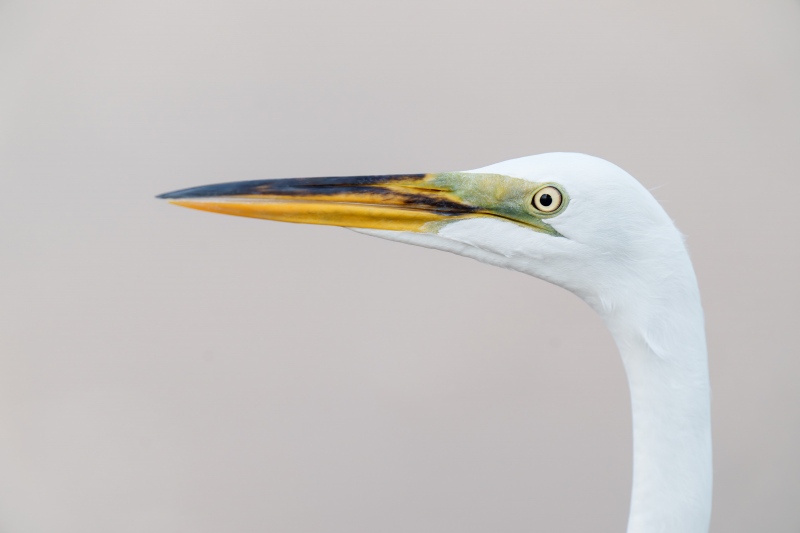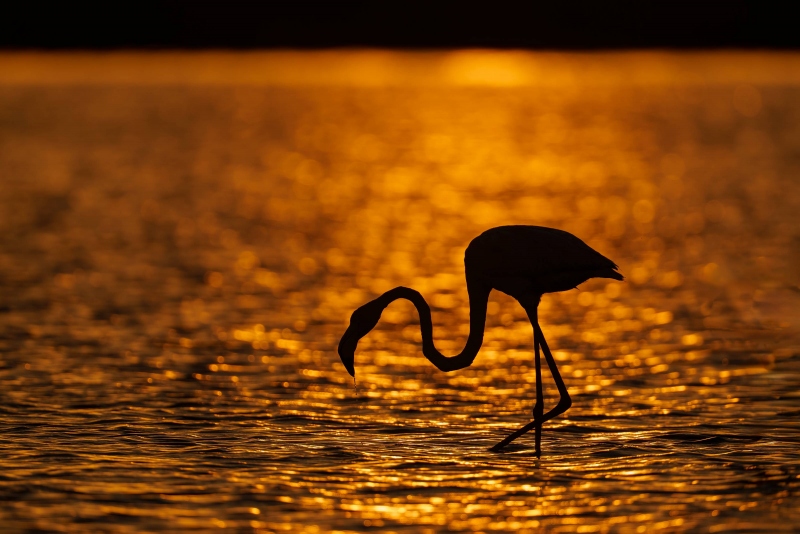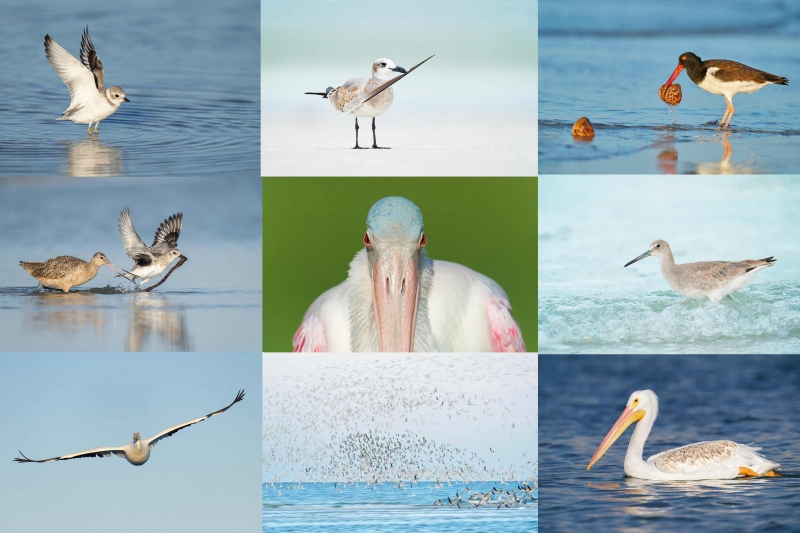What’s Up?
DeSoto is on fire right now. Wednesday morning was fantastic. With clear skies and a strong wind from the east (wind against sun), I opted to stay in on Wednesday afternoon. Two cooperative, un-banded!, Hurricane Idalia-driven flamingoes showed up on Thursday morning and were photographed by about 25 photographers, almost all of them shooting 90 degrees or more off sun angle. In addition, I was surrounded by some of the several thousand shorebirds and some of the several thousand migrant and wintering terns. Thursday morning was mega. I was planning on staying in again on Thursday afternoon, but when I checked the Windy App, I saw that the wind had switched to the north by west. I drove down to the park, grabbed the 200-600, and headed north. That session turned out to be the very best of my three-day busman’s holiday. I kept 59 out of more than 2,000 flight shots. My best images, however, were of a juvenile Caspian Tern and a winter male American Avocet. When I started back to my car at 7:20pm, I was exhilarated.
Friday morning was decent; my best images were some tern blastoffs and the flamingo silhouettes — there were three un-banded that morning. As it is already five weeks after the hurricane, there is a good chance that some flamingos will hang around for the fall DeSoto IPTs. Note that American Flamingo is a Code 4 rarity on the American Birding Association list. I doubt that the several dozen flamingos in Florida will hang around to breed as I am not aware of any suitable breeding habitat — shallow salt or brackish water flats or alkaline lakes. That said, they did breed in Florida historically before being extirpated by hunting for the plume trade.
FYI: ABA Rare Bird Codes
Code 3: Rare. Species that occur in very low numbers, but annually, in the ABA Checklist Area. This includes visitors and rare breeding residents.
Code 4: Casual. Species not recorded annually in the ABA Checklist Area, but with six or more total records-including three or more in the past 30 years-reflecting some pattern of occurrence.
Code 5: Accidental. Species that are recorded five or fewer times in the ABA Checklist Area, or fewer than three records in the past 30 years.
|
|
|
This image was created on 12 May 2023 at Fort DeSoto Park, South of St. Petersburg, FL. I used the handheld Sony FE 400mm f/2.8 GM OSS lens with the Sony FE 1.4x Teleconverter, and The One, the Sony Alpha 1 Mirrorless Digital Camera). The exposure was determined via Zebra technology with ISO on the Thumb Dial. ISO 1000: 1/1000 sec. at f/5.6 (stopped down one stop) in Manual mode. When evaluated in RawDigger, the raw file exposure was determined to be dead-solid perfect. AWB at 9:09:17am on a partly cloudy morning. Tracking: Zone/AF-C with Bird Face/Eye detection enabled performed to perfection. Be sure to click on the image to enjoy a high-res version. Great Egret “studio head shot” |
The Why Stop Down? Question
In the Concrete Backgrounds blog post here, I wrote:
Depth-of-Field Question
Why did the man who loves to shoot wide open stop down one full stop?
This topic has been addressed here dozens of times. Many folks were kind enough to leave comments; all but this one were incorrect:
Anthony Ardito: October 2, 2023 at 7:14 pm.
You stopped down because you were very close to the subject. Being so close, you had just a “sliver” of depth of field.
Above was the only correct answer.
Try this:
THINK ABOUT STOPPING DOWN ONLY WHEN YOU ARE WORKING VERY CLOSE TO A BIRD, AT NEAR POINT BLANK RANGE, CLOSE TO THE MINIMUM FOCUSING DISTANCE OF THE LENS.
Do understand that even when you stop down in such situations, you will not gain very much additional depth of field. At f/4 for the image above, the total DOF is .78 inches. Stopping down one stop to f/5.6 gets you to 1.18 inches of total DOF, an increase of 0.4 inches.
|
|
|
This image was created 6 October 2023 at Fort DeSoto Park in Pinellas County, FL. Standing at full height, I used Robus RC-5558 Vantage Series 3 Carbon Fiber Tripod topped by the Levered-Clamp FlexShooter Pro with the Sony FE 600mm f/4 GM OSS lens with the Sony FE 1.4x Teleconverter (at 840mm) and The One, the Sony Alpha 1 Mirrorless digital camera. Exposure was determined via Zebra technology with Exposure Compensation (EC) on the thumb dial. Shutter Priority -1/3 stop. AUTO ISO set ISO 100. 1/1000 sec. at f/5.6 (wide open). AWB at 7:36:11am with some light low clouds in the eastern sky. Tracking: Expand Spot AF/C worked perfectly. Click on the image to enjoy a larger, sharper, hi-res version. American Flamingo feeding at sunrise |
Seeing the Shot
I was walking north when I spotted first two, then three flamingos foraging in the distance well ahead of me to my right. With light clouds on the eastern horizon, I knew instantly where I needed to be. I passed six photographers in a small group photographing the birds from a mile away in 100% boring light. I continued north until the birds were lined up with the rising by well-muted sun. From where I stood, I was able to shoot some pleasing blurs of the huge ten flocks further to the north before the sun broke through. When that happened, I turned to my right, lined the birds up with the brightest highlights on the water, raised the shutter speed from 1/30 second to 1/1000 second, and adjusted the EC. Bingo!
High Level Exposure Question
When evaluated in RawDigger, the raw file exposure was determined to be absolutely perfect despite the 171,00 over-exposed pixels. All are invited to leave a comment explaining why this was the prefect exposure for this situation. To arrive at the answer, ask yourself these questions:
1- Where were all of those OvExp pixels?
2- If all of the over-exposed pixels have been eliminated, what would the image have looked like?
High Level Mode Question
I state often that folks should be working in Manual mode for 95+ percent of their bird photography. Study all of the EXIF data and leave a comment letting us know why you think I was working in Shutter Priority with Exposure Compensation on the thumb dial. Note: there are other clues throughout this post.
Perspective Question
In this situation, why would getting very low have been the completely wrong option? This is an easy one.
How Did You Do?
I you are baffled by one or more of the questions above, if you want to learn to see the shot, and want to make yourself a better bird photographer, consider joining me on a DeSoto IPT. I am offering a $500 discount off the Fall #2 DeSoto IPT to anyone wishing to share an AirBnB with me.
|
|
|
All images from SEPT/OCT/NOV at Fort DeSoto. Click on the image to enjoy a larger, sharper high-resolution version. Clockwise from upper left to center: Piping Plover flapping after bath, juvenile Laughing Gull with feather, American Oystercatcher with sea urchins, Willet foraging in surf, American White Pelican juvenile swimming, skimmer/tern/shorebird blast-off blur, American White Pelican in flight, Black-bellied Plover stealing lugworm from Marbled Godwit, Roseate Spoonbill staring. |
The Fall 2023 Fort DeSoto Instructional Photo-Tours
Fall 2023 Fort DeSoto Instructional Photo-Tour #2
3 1/2 Days: Tuesday 17 October through the morning session on Friday 20 October 2023. $1899.00 includes three working lunches. Limit six photographers.
Fall 2023 Fort DeSoto Instructional Photo-Tour #3
3 1/2 Days: Tuesday 31 October through the morning session on Friday 3 November 2023. $1899.00 includes three working lunches. Limit six photographers.
Fall 2023 Fort DeSoto Instructional Photo-Tour #4
3 1/2 Days: Tuesday 14 November through the morning session on Friday 17 November 2023. $1899.00 includes three working lunches. Limit six photographers/Openings: four.
Fall Bird Photography at Fort DeSoto
Fort DeSoto, located just south of St. Petersburg, FL, is a mecca for migrant shorebirds, terns, and gulls in fall. There they join hundreds of egrets, herons, and night-herons that winter on the T-shaped peninsula. With any luck at all, we should get to photograph one of Florida’s most desirable shorebird species: Marbled Godwit. Black-bellied Plover and Willet are easy, American Oystercatcher is pretty much guaranteed. Great Egret, Snowy Egret, Great Blue Heron, Tricolored Heron, and White Ibis are easy as well and we will almost surely come up with a tame Yellow-crowned Night-Heron or two. And there should be some quality Brown Pelican flight photography. In addition, Royal, Sandwich, Forster’s, and Caspian Terns will likely provide us with some good flight opportunities as well. Though not guaranteed, Roseate Spoonbill and Wood Stork might well be expected. And we will be on the lookout for a migrant passerine fallout in the event of a thunderstorm or two.
On this IPT, all will learn the basics and fine points of digital exposure. Nikon and Canon folks will learn to get the right exposure every time after making a single test exposure, and SONY folks will learn to use Zebras so that they can be sure of making excellent exposures before pressing the shutter button. Everyone will learn how to approach free and wild birds without disturbing them, to understand and predict bird behavior, to identify many species of shorebirds, to spot the good situations, to choose the best perspective, to see and understand the light, and to design pleasing images by mastering your camera’s AF system. Most importantly, you will surely learn to evaluate wind and sky conditions and understand how they affect bird photography. And you will learn how and why to work in Manual mode (even if you’re scared of it). The best news is that you will be able to take everything you learn home with you so that you will be a better photographer wherever and whenever you photograph.
|
Clockwise from upper left to center: Long-billed Curlew, juvenile Tricolored Heron, Marbled Godwits, Great Blue Heron, juvenile Pectoral Sandpiper, Wood Stork, smiling Sea Scallop, Ruddy Turnstone scavenging needlefish, Great Blue Heron sunset silhouette at my secret spot, and southbound migrant tern flock blur. |
The Details
There will be a Photoshop/image review session during or after lunch (included) each full day. That will be followed by Instructor Nap Time.
These IPTs will run with only a single registrant (though that is not guaranteed). The best airport is Tampa (TPA). Once you register, you will receive an e-mail with Gulfport AirBnB/VRBO information. If you register soon and would like to share an AirBnB with me, shoot me an e-mail. Other possibilities including taking a cab to and from the airport to our AirBnB and riding with me for $50/day. This saves you both gas and the cost of a rental car.
A $600 deposit is due when you sign up and is payable by credit card. Balances must be paid by check one month before the trip. Your deposit is non-refundable unless the IPT sells out with six folks, so please check your plans carefully before committing. You can register by calling Jim during weekday business hours at 863-692-0906 with a credit card in hand, or by sending a check as follows: make the check out to: BIRDS AS ART and send it via US mail here: BIRDS AS ART, PO BOX 7245, Indian Lake Estates, FL 33855. You will receive a confirmation e-mail with detailed instructions, clothing, and gear advice. Please shoot me an e-mail if you plan to register or if you have any questions on lodging.
Up Early, Stay Out Late!
Obviously, folks attending an IPT will be out in the field early and stay late to take advantage of the sweetest light and sunrise and sunset colors (when possible). The good news is that the days are relatively short in early fall. I really love it when I am leaving the beach on a sunny morning after a great session just as a carful or two of well-rested photographers are arriving. On cloudy days, we may — at the leader’s discretion, stay out in the morning for a long session and skip the afternoon session. To ensure early starts, breakfasts will be your responsibility. And so that we can get some sleep, dinners will sometimes be on your own as well.
Typos
With all blog posts, feel free to e-mail or to leave a comment regarding any typos or errors.


















Hi Artie,
Stunning silhouette capture. For your questions:
1. Glowing highlights on the water.
2. Most probably a black picture with little bit gold here and there.
High Level Mode Question
-It will be easy to get the desired outcome quickly.
Perspective Question
– The sun will be on the frame and you may have to do the exposure comp again.
Hi Melinda,
1- Yes, the specular highlights — they are reflections of the sun itself.
2- Good!
High Level Mode question — yes, in part. See Monday’s blog post for more on this one.
Last comment. No. Again, see below or Monday’s post.
with love, artie
Artie
5 feet lower would have put the horizon into the picture and possibly intersecting the back of the flamingo.
I try hard in your teachings and think of those things in the field.
Oh come now you not getting excited i know you do or you wouldn’t keep going back, it is in your blood 🙂
Always with love b
Yes, lower would have resulted in a black on black silhouette — NTG!
Figuring that stuff out comes with experience. I have 39 years on you 🙂
I am excited every time I head out into the field. What I was saying was that at that for those few minutes I was not excited as I had to concentrate so hard on getting the technical stuff right. There are many times when I am getting set up that I can barely breathe and I am praying that the bird does not fly away or otherwise ruin what I am seeing.
love you man, a
Robert,
Surprisingly, I was not that excited. I was too worried about the techs and about getting the bird in the brightest water.
1- Elinor’s answer was better.
2- Correct. Correct in part.
3- Perspective. At 840mm, getting five feet lower would not have put the sun in the frame as it was 20 minutes after sunrise … Try again.
Thanks for your kind words.
with love, a
If you were lower the bright sun would probably be in the photo, or almost in, making exposure impossible.
Where were the overexposed pixels? In the highlights on the water. If they were made darker the whole photo would have been black.
On your first comment, see my reply to Bob.
Good on the specular highlights.
with love, artie
Artie,
Wonderful sunrise photo, agree with Bob that your heart must have been pumping when you saw the image.
The overexposed pixels were probably in the center of the frame.
If you got down low the sun would have made it difficult to get the image and there would be larger portions overexposed.
Agree with Bob on the use of SP in this situation.
Thanks for posting and sharing.
Monte
Thanks, Monte. There are several clues as to why I was using Shutter Priority but nobody made the connection … IAC, you are both right in part …
with love, artie
Image #1 and #3 and #4 are interesting and well made! Image #2 American Flamingo feeding at sunrise is too dark to really see the photo.
Artie
A beautiful photo on the sunrise i bet your heart was pumping and seeing the beautiful image.
1: I believe they were in the very bright spots of the water closest to you almost dead center.
2: Really dark and could be almost Black.
Shutter Priority lets you pick the SS and exposure to see Zebras and can quickly adjust up or down with one click of the wheel and lets the camera picks the ISO
Perspective: You would have got your butt wet, and put the sun coming up really in the frame and blown out more pixels.
Beautiful photo to capture the beauty of a wonderful sunrise!
Always with love b